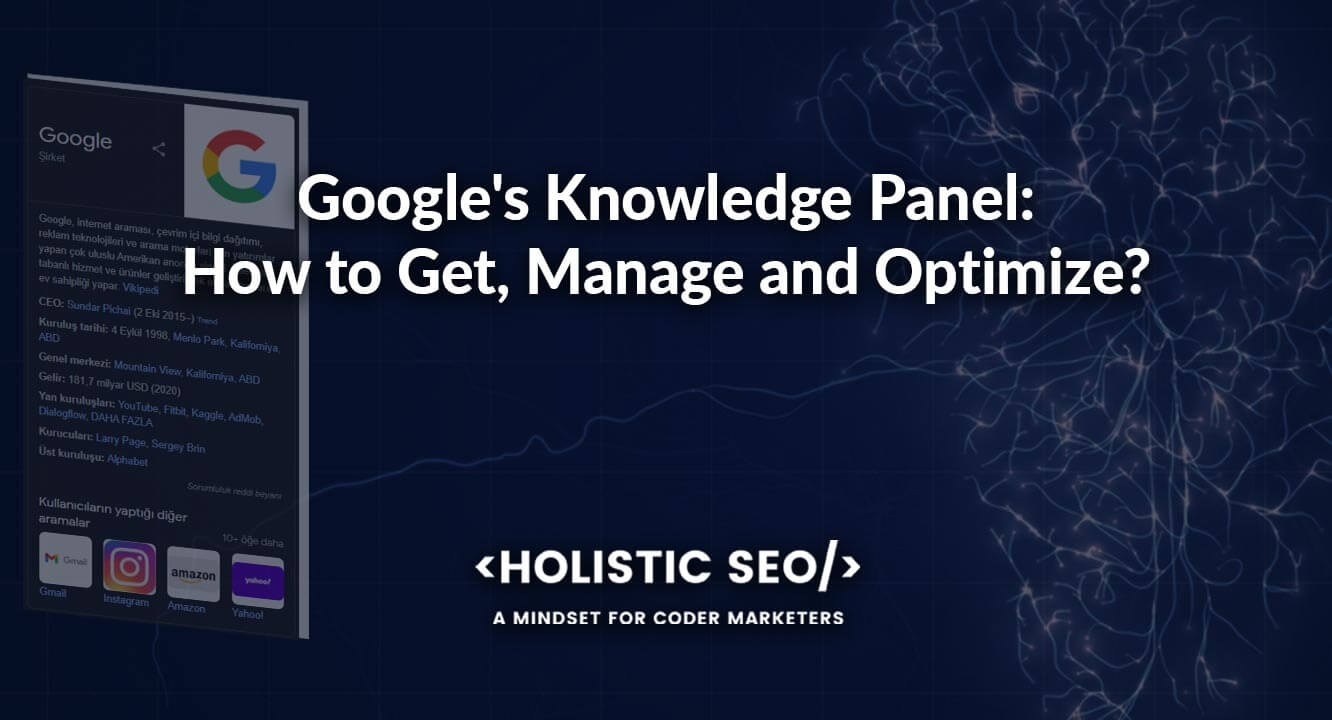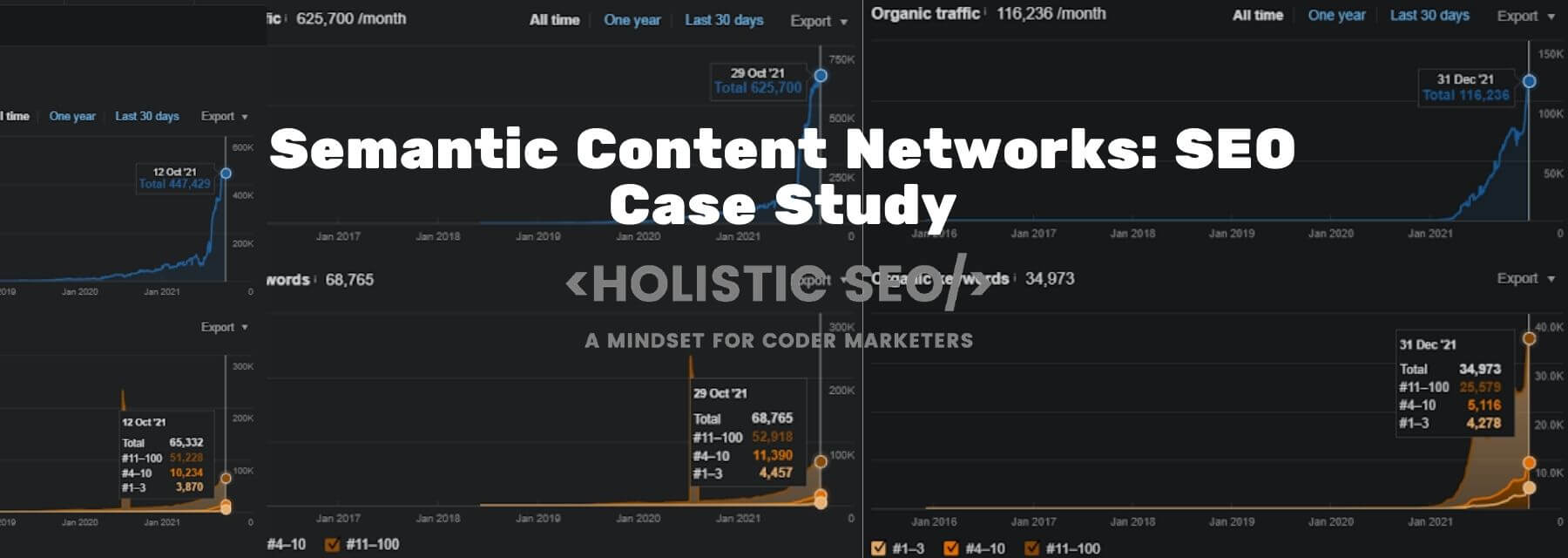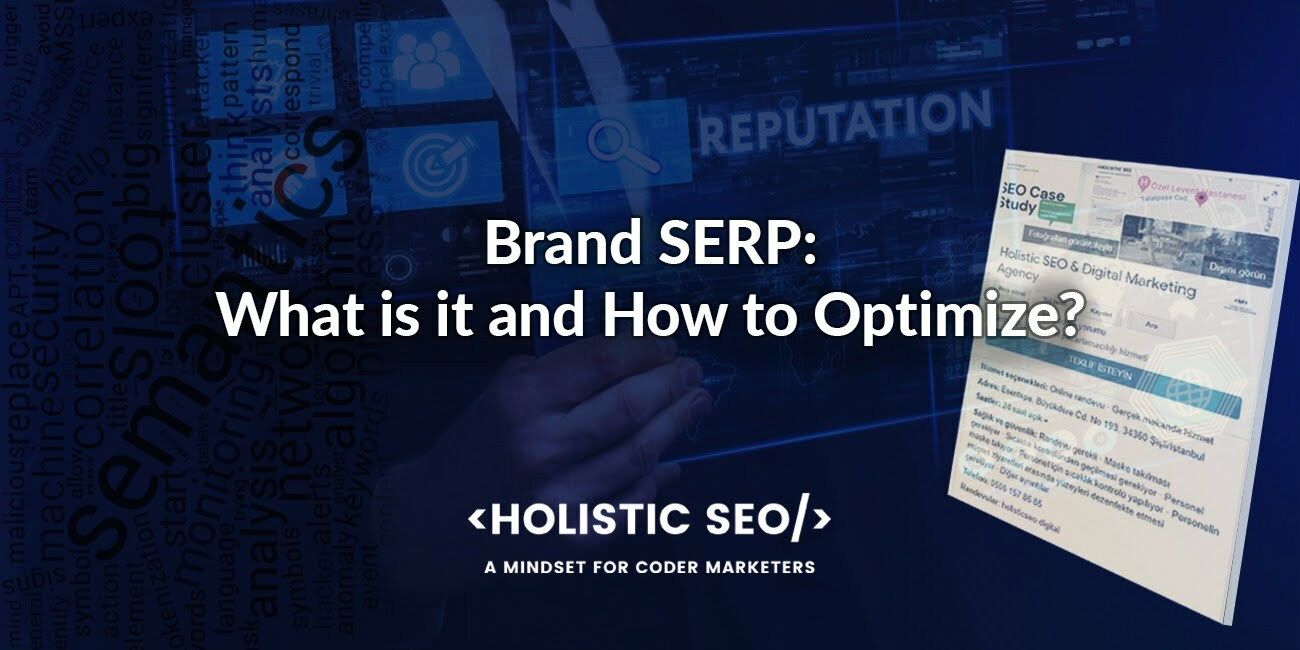A knowledge panel is an information box that can show an entity’s features, attributes, and prominence for a topic with the information from Google’s Knowledge Graph.
Information in knowledge panels is automatically generated, and information appears from different sources on the web. Google can combine information from various open web sources with data provided by data partners on specific topics, such as movies or music. Google’s knowledge panels include the information of prominent entities from nature (self-authoritative) such as prominent individuals or the creators of a television show. Google can choose different images for a knowledge panel that defines the entity from the open web. Google gives some control over the Knowledge Panel for the owner of the entity by allowing them to claim the panel and give more information, or feedback for the contents of the Knowledge Panel.
What Can a Knowledge Panel Include?
A knowledge panel from Google, Yandex, Bing, or another Search Engine can include the sections and information below.
- Name of the entity
- Representative image(s) of the entity
- Social Media Accounts of the entity
- Description of the entity
- The inception date of the entity
- Superior and Inferior organizations of entity (if it is a company)
- Siblings, children, spouse, father, and mother (if it is a person)
- Cameos Videos for the entity (if the entity is a person and celebrity with a Google Cameos Account)
- Questions that are generated by the Search Engine for the entity, and their answers.
- Entity description from an authoritative source for the specific entity
- Books, songs, awards of the entity (if the entity is a person)
- Population, GDP, capital city (if the entity is a country)
- Subtitle of the Entity to define it further such as consultant, internet entrepreneur and more.
- Posts of the Entity’s Representative (Since, July 2021 Google removed the Posts for Knowledge Panel)
- Official website of the named entity
KalicubePro can track most of the sections, and information for a specific Knowledge Panel, and suggest simple SEO strategies to push certain types of content, sources to trigger or broaden a Knowledge Panel instance.
What is Knowledge Panel Management?
Knowledge Panel Management is the process of organizing and optimizing a knowledge panel for an entity from the search engine result page. To optimize, and organize the information on a Knowledge Panel for an entity, consistent information should exist on different sources on the web, and the entity should be notable, prominent, and authoritative. Knowledge Panel Management includes posting for the specific entity, or publishing videos from the Google Cameos for the specific questions from the audience, and correcting the information on the Knowledge Panel.
Many Knowledge Panels on Google and other search engines’ SERP can include inaccurate information. Thus, Search Engines follow three different methods to improve the quality of the knowledge panels for helping the web search engine users.
- Giving control and audit authority to the representative of the entity, or owner of the identity.
- Taking feedback from the search engine users about specific information in the knowledge panel.
- Improving, updating, and developing knowledge graph of the search engine for the specific real-world named entities.
Entities from Knowledge Graph can have a description, attribute list, features, similar, and related entities to other entities. To recognize the entities by improving the real-world understanding, a search engine can use named entity recognition.
How to Manage Knowledge Panel of an Entity?
To manage a Knowledge Panel Entity, the methods and steps below can be used.
- Claim the entity’s ownership in terms of identity, and representativeness.
- Understand the important similarities and other entities, their prominence for the same industry.
- Grasp the attributes and features of the specific entity type.
- Create consistent information on different authoritative sources.
- Choose the most authoritative sources for a specific industry to manage the knowledge panel of the entity.
- Give feedback to the search engine related to the wrong, or missing information.
- Help search engine to understand the identity of the specific entity for disambiguation.
- Use distinctively definitive images for the specific entity’s identity, if it is a person, include a clear face view, if it is a landmark, use a comprehensive landscape image for the landmark.
- Use the entity’s identity points, and link all of them to each other so that the search engine’s entity disambiguation algorithms can clarify the identity of the entity while increasing the confidence and relevance score for specific terms.
- Use Google Knowledge Graph API to see which entity is connected to the which one in which language for which phrases with which relevance and confidence score.
- Use a Knowledge Panel Management SEO technology such as Kalicube Pro to track the changes, or find the most important sources for a knowledge panel.
To use Google’s Knowledge Graph API with Python, understand Google’s knowledge graph, and its working principles, please read the related guide.
An Example of Knowledge Panel Management
An example of Knowledge Panel Management will be demonstrated through the named entity “Koray Tuğberk GÜBÜR”. The named entity Koray Tuğberk GÜBÜR has the type of a person, and the education attribute in his knowledge panel initially showed “Yeditepe University”. One day, in the summer of 2021, the education attribute in his knowledge panel changed and indicated “Yeditepe Tourism Department”.
The truth is, Koray Tuğberk GÜBÜR graduated from the Advertising Communication and Design branch of Yeditepe University. Since the statement “Koray Tuğberk GÜBÜR graduated from Yeditepe Tourism Department” is not true, having this information showing prominently in his Knowledge Panel is not good for public relations, or entity reputation. As an SEO, having a degree in Marketing and Advertisement is an advantage, because it shows that the person is a trained marketer. An SEO who graduated from a Tourism School would appear less credible. The other harm of this unwanted change is that Yeditepe University has prestige, and losing that prestige on the Knowledge Panel of the named entity is a big loss for the entity’s reputation. Being a graduate of a “tourism department” and being a graduate of a “university” have very different values for the first impression.
In the screenshot below you will see that the Knowledge Panel of the Koray Tuğberk GÜBÜR shows “Yeditepe Tourism Department” within the education attribute. To find the reason why this information changed, the entity-defining sources and corroboration pages should be checked. In this context, the first place to check is obvious: the target of the link for that attribute in the Knowledge Panel.
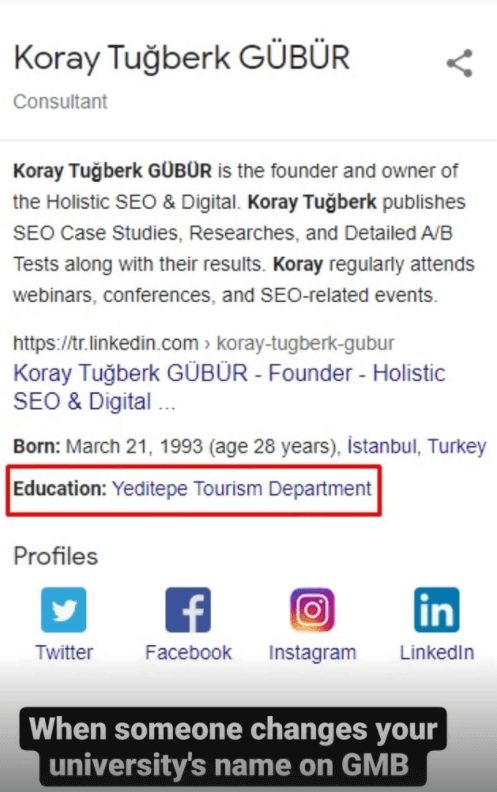
If you click an attribute’s value within the knowledge panel, if the attribute value is another named entity, you will be redirected to the related named entity’s Brand SERP. In other words, every Brand SERP and Knowledge Panel are connecting each other as attributes of each other based on context, and the relationship(s) between them. Importantly, even if Google initially takes the data from Wikipedia or Wikidata, once the entity is in Google’s Knowledge Graph, the algorithms start to use additional owned and unowned sources (such as Google My Business, Crunchbase, and many others) to continue to improve and expand understanding of the entity. In this example, someone has changed the name of Yeditepe University’s name in Google My Business and that has affected the understanding of the Knowledge Graph. Below, you will see how it is being shown within the autosuggest of Google.
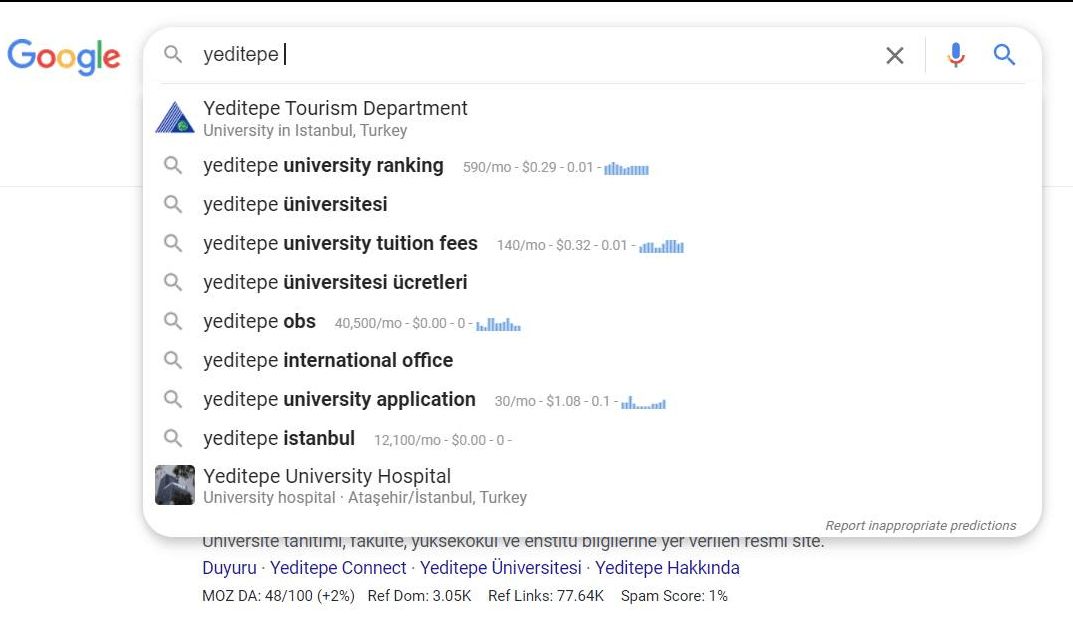
Below, through Google Trends data, you will see how the “new name” of Yeditepe University has been shown. And right below that, you will see that Google also recognizes events and event organization’s attendees.

We have an entity called “Istanbul Yeditepe University – Bogazici University” which was a sports match between two different universities. And, search engine Google recognized these named entities and their relation to each other. But despite this connection, it didn’t manage to create a proper named entity recognition and relation detection process, because the entity name was not “Yeditepe Tourism Department” within other areas.

Checking other related entities that include a relation with the targeted named entity is useful to see to what extent the related information changed. For instance, when a named entity changes its name, does it affect its position on the knowledge graph in terms of relevance for certain phrases, or does it change for other related named entities? In this context, below you can see how the name within the Google My Business affects the place-related attributes within the Knowledge Panels of named entities.

Below, you can see the result of the wrong education information in the Knowledge Panel. To fix the wrong information within the knowledge panel, the attribute with the wrong information should be chosen to see the information source of Google. In this example, it is Google My Business. Below, you will see how Google uses the GMB names within the Knowledge Panels.

Based on that, the solution for this knowledge panel management work is to make a request to Google Maps to change the related named entity’s name to “Yeditepe University”, which I did.
Note: Even after the entity’s name change is accepted, the name on the map image doesn’t change immediately. In other words, based on entity reputation management, fixing the related entities’ names and information can happen with different timings on different Google surfaces.

When I change back the “Yeditepe University”s name back with the help of Google My Business Support Team, they have changed the name of the entity within the graphical user interface of Google Search, in other words, the SERP.
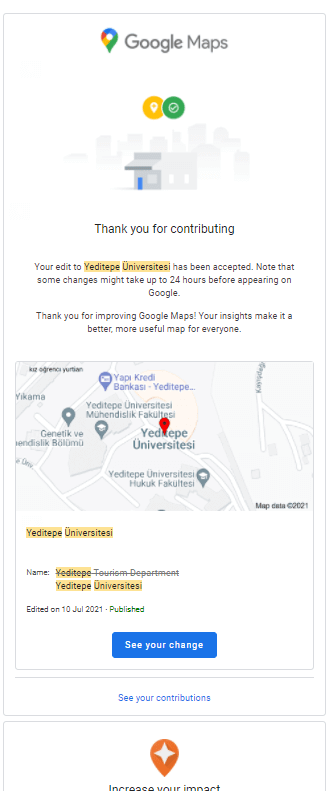
Below you will see the successful result of the Knowledge Panel Management for the named entity Koray Tuğberk GÜBÜR. The attribute of “Education” and its value has been fixed. From, “Yeditepe Tourism Department” to the “Yeditepe University”.
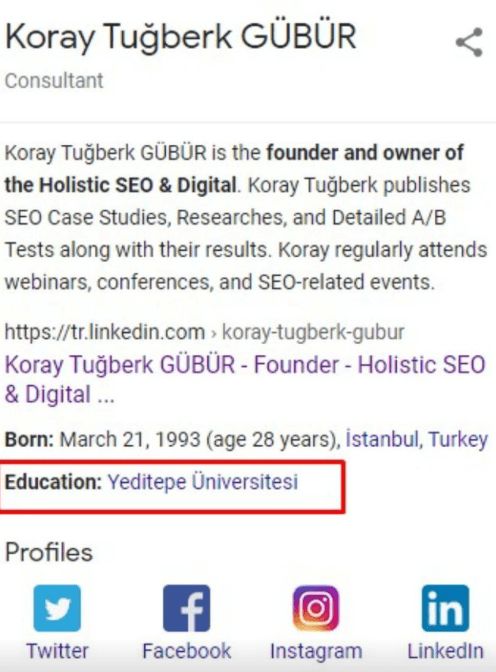
During this Knowledge Panel Management example, Jason Barnard‘s help, and vision were precious. I recommend that you check his education series for Brand SERP, and Knowledge Panel Management, and follow Jason on Twitter.
What is the Relationship Between Knowledge Panel Management and Brand SERP Optimization?
The relationship between Knowledge Panel Management and Brand SERP Optimization involves their correlation with each other in terms of information that is included, and velocity of change. For example, a Brand SERP instance that includes social media accounts can have a knowledge panel that includes the same social media accounts within the Knowledge Panel. A Brand SERP can include controllable, semi-controllable, and uncontrollable information sources, and the same is valid for Knowledge Panels. A knowledge panel can include related entities for the subject entity in the section of the “People also Search”, or “People also looked for” section, and the same entities from the knowledge panel can exist within the Brand SERP.
As you saw in the previous article, when it comes to Brand SERPs, Image SERP, Video SERP, News SERP are important. Rich SERP features for different search verticals often appear within the “Web” (“All”) section of the brand search engine result pages. These verticals are also important to Knowledge Panels since they can have images from the Image section, and the subtitles of the Knowledge Panel can change based on recent and consistent news from the news section. If the person is an actress or actor, the knowledge panel can include videos from the video vertical and video search for the specific named entity.
The relationship between the Brand SERP and the Knowledge Panel is based on mutual information and interactivity with each other. Thus, Knowledge Panel Management and Brand SERP Optimization are closely related to each other and driven by extensive information with consistency from the open web. Another side of the relationship between Brand SERP Optimization and Knowledge Panel Management is that Knowledge Panels are placed within the Brand SERP and, based on the device, they can be separated or blended, with different levels and orders.
Why should you use Kalicube Pro for Knowledge Panel Management?
Kalicube Pro is a Brand Reputation and Digital PR technology that focuses on Search Engine Optimization for named entities by providing reliable and relevant information for named entities while also tracking the changes of Brand SERP, Knowledge Panel, and Knowledge Graph in multiple regions and languages. In the context of Knowledge Panel Management, Kalicube Pro can track different named entities from different languages, and regions from Google’s own Knowledge Graph, and the Knowledge Panel of these entities. Kalicube Pro provides a detailed Brand SERP optimization guide, as well as a prioritized task list for getting, changing, optimizing an entity’s knowledge panel.
I recommend using Kalicube Pro for Knowledge Panel Management, for getting a Google Knowledge Panel faster and optimizing it according to the real-world identity of the named entity by helping Google to understand the entity’s existence, character, and connection to other entities.
Last Thoughts on Knowledge Panel Acquiring, Managing, Optimizing, and Holistic SEO
Knowledge Panel Acquiring (Getting), Managing, and Optimizing are connected to Holistic SEO. A search engine can collect information from multiple verticals of search, from local guides, Google Posts, Play Store to the Knowledge Panels, and Brand SERPs. Holistic SEO tries to cover every area and surface of a search engine with the profiles, understandings, and perspectives of the search engine itself, and search engine’s managers, creators, engineers. Without having empathy for the search engine, search engine optimization won’t be able to show its full potential. Thus, having a knowledge panel for the brand will help the search engines to trust the named entities’ relevance for another entity, and related topics, interest areas, queries, and search behaviors. Managing, and optimizing a knowledge panel includes the process of feeding the search engine’s informational database with consistent, and extensive data so that the search engine can improve the confidence score for the relevant information so that it can show them within the Brand SERP and its Knowledge Panel section.
Knowledge Panel Management is a part of Holistic SEO, and within the SEO Projects, getting a Knowledge Panel for the purpose of reflecting the named entity’s character better is one of the important aspects.
Google Knowledge Panel Getting, Optimizing, and Managing guide will be updated in the light of new information.
- Sliding Window - August 12, 2024
- B2P Marketing: How it Works, Benefits, and Strategies - April 26, 2024
- SEO for Casino Websites: A SEO Case Study for the Bet and Gamble Industry - February 5, 2024
